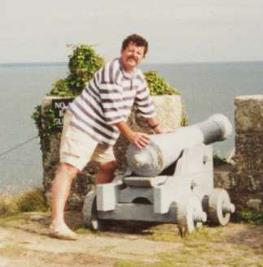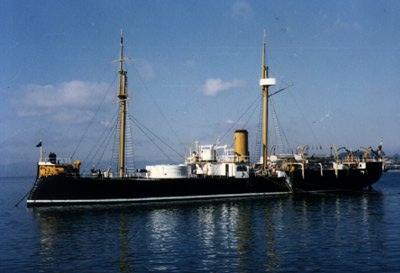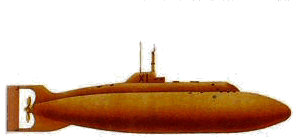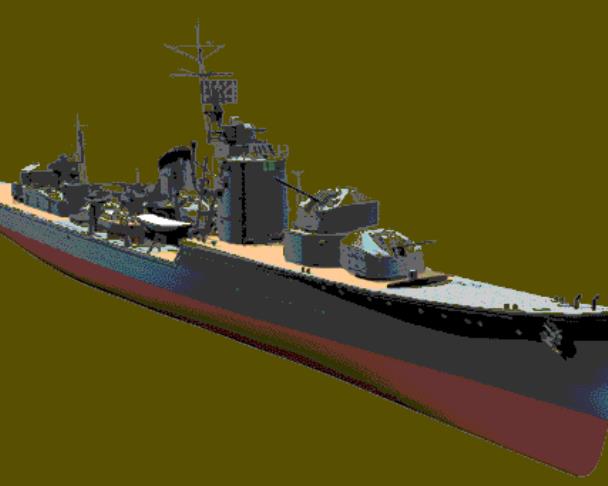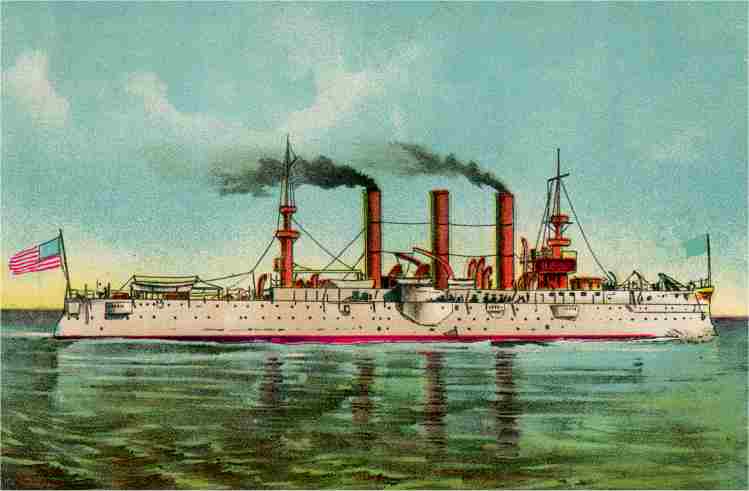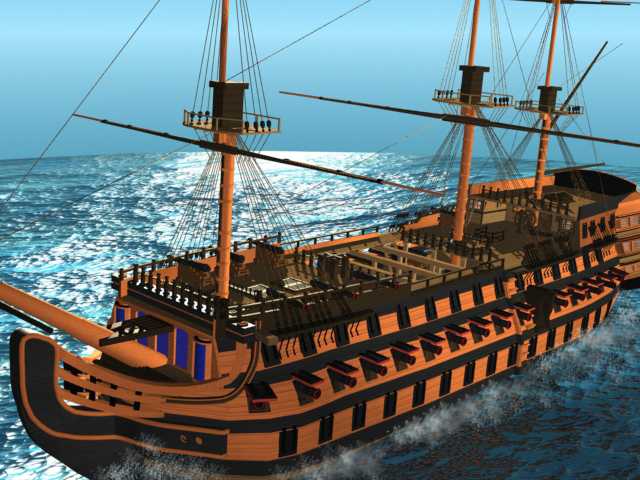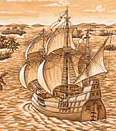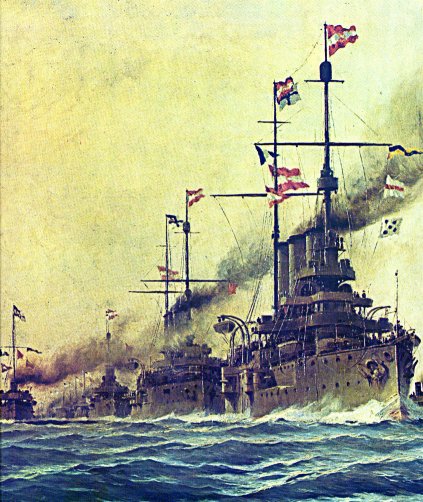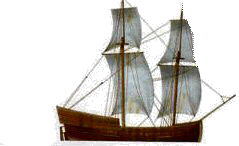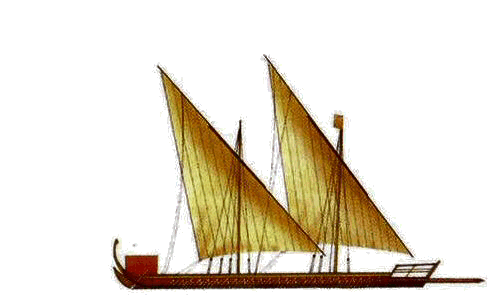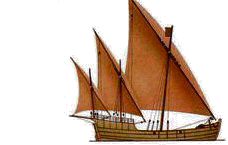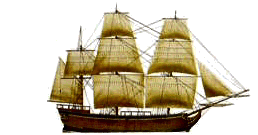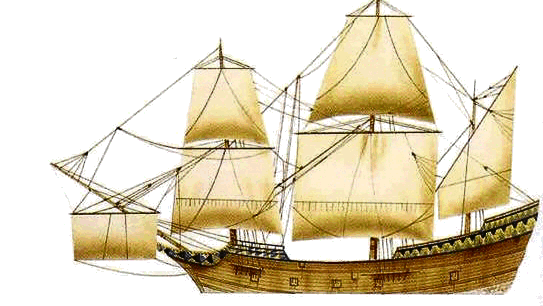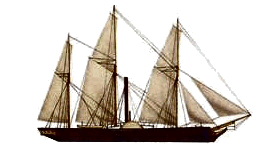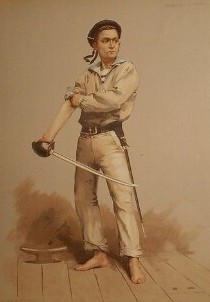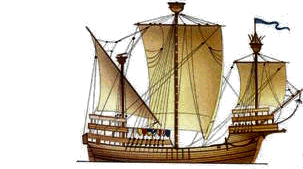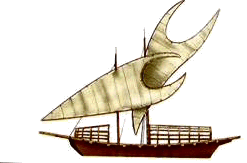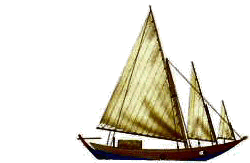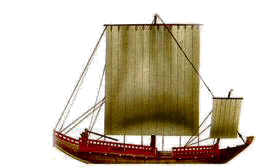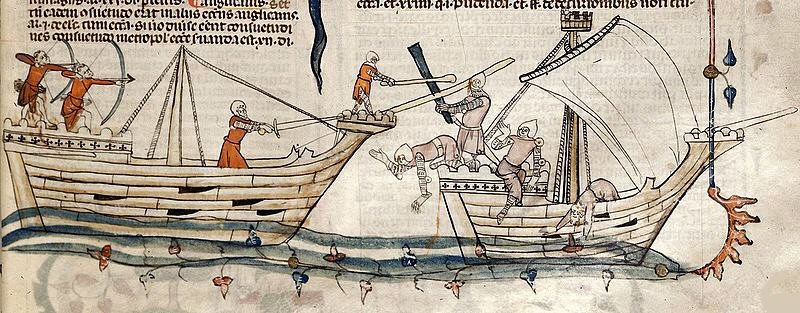Battle of Cashi 1161 Tuesday, 12/12/06, 6:50 AM
The Jurchen Jin were trying to force their way south across the estuary of the Yangtze. The Song navy consisted primarily of paddlewheel ships, which were faster and more maneuverable than the Jin ships, providing the Song with a great advantage. They hid their fleet behind the island of Jinshan, and brought them out at the signal of a mounted scout atop the island's peak. The Song then bombarded the invaders with traction trebuchets, launching "thunderclap bombs," which were soft- cased explosives filled with lime, which would create a noxious cloud when the fuses went off and broke the soft cases. The Jurchen Jin were so badly defeated that the Jin Emperor was assassinated by his own men.
From: near Shanghai
Web Site: Wikipedia
Chinese naval history Monday, 11/27/06, 5:49 AM
Three Kingdoms Battle of Red Cliffs Sui Dynasty Goguryeo-Sui Wars Tang Dynasty Battle of Baekgang Song Dynasty Battle of Yamen Ming Dynasty ¿ Battle of Lake Poyang ¿ Zheng He ¿ Wokou ¿ Imjin War Qing Dynasty ¿ Zheng Chengong ¿ Beiyang Fleet ¿ Opium War ¿ Sino-French War o Battle of Foochow o Sino-Japanese War o Battle of Yalu River (1894) Republic of China Republic of China Navy People's Republic of China ¿ People's Liberation Army Navy ¿ First Taiwan Strait Crisis ¿ Second Taiwan Strait Crisis ¿ Third Taiwan Strait Crisis ¿ Battle of Hoang Sa (1974)
Web Site: Wikipedia
The Black Sea 1914-18 Friday, 4/7/06, 10:15 AM
Web Site: courtesy of Martin James
Naval battles by body of water Thursday, 3/23/06, 7:59 AM
a very comprehensive list of fleet actions and the more interesting smaller engagements, broken down geographically.
From: worldwide and throughout time
Web Site: Thewartourist
Battle of the Nile c. 1190BC Wednesday, 3/22/06, 4:06 AM
The Egyptians trapped the 'Sea Peoples' in the Nile delta, the sails of whose ships were furled. They grappled the invader ships, immobilizing them; soldiers boarded their ships and attacked the enemy whilst archers on shore supplied fire power. The use of archers (on sea and on land) provided long range fire power and helped the Egyptians to overwhelm the 'Sea Peoples', whose ships MAY have been wholly sail-powered. A long article, well illustrated from ancient inscriptions and murals.
From: Nile delta
Web Site: SA Military History Journal
Action on the Tunting Lake circa A.D. 265 Monday, 3/20/06, 8:57 AM
The supreme authority in Wei passed from the family of Tsowpi to his best general, Ssemachow, who had the satisfaction of beginning his reign with the overthrow of the Chow dynasty. The combined resources of the two states were then directed against the southern principality of Ou, but the conquest of Ou was put off for twenty years. Ssemachow died in A.D. 265, and his son Ssemachu founded the new dynasty of the Later Tsins under the name of Vouti, or ¿warrior prince¿, with a capital at Loyang. Vouti ordered the invasion of Ou from two sides. He placed a large fleet of war junks on the Yangtse-kiang river to attack his opponent on the Tunting Lake, a very large freshwater lake in east central China. After his army had suffered several reverses, Sunhow of Ou surrendered. Thus was China again reunited for a short time under the dynasty of the Later Tsins. Vouti gave himself up to the pursuit of pleasure, by entertaining a theatrical company of five thousand female comedians, and by allowing himself to be driven in a car drawn by sheep through the palace grounds. His son, Ssemachong, or Hweiti, became emperor on his death in A.D. 290.
From: East central China
Web Site: Ebooks
"Castle ships¿ and "Precious ships" of Ancient China Monday, 3/20/06, 5:53 AM
With a long coastline stretching along the broad water areas of Bohai, Huanghai, Donghai, and Nanhai, China enjoys a special water environment. During the Qin (221-206) dynasty, the Qin Emperor Qin Shihuang led a fleet composed of lou chuan (castle ships, or war ships with deck castles) for an assault on the Chu State. After the unification of all of China, he also navigated at sea. The Han Dynasty could mobilize over 2,000 castle ships and 200,000 seamen. Various kinds of warships could be found, such as Xian Deng -- an assault ship, Meng Chong -- a narrow warship for striking the enemy's warships, and Ben Ma -- a ship as fast as a galloping horse. However, the assault castle ship was still the most important among all the ships and constituted the main force of the navy. The Wu State of the Three Kingdoms Period (220-280) once built a five-story ship that could hold up to 3,000 soldiers. The Southern Dynasty (420-589) could build big ships with a holding capacity of 1,000 tons in the southern areas of the Yangtze River. In order to enhance the ship's speed, the Southern Qi Dynasty invented the manpowered paddle wheel ship. Though not as efficient as the sail, the paddle wheel ship was recognized as a significant invention. China's shipbuilding industry entered a period of maturity in the Tang (618-907) and Song (960-1279) dynasties. Utilization of many shipbuilding techniques, such as the stern helm, scull, and sails, were further improved during this period. The Sui Dynasty, though short lived, developed the capacity to build giant dragon boats. Assembled with mortise-and-tenon joints, the dragon boats were much stronger than those connected with iron or bamboo nails. Among the various ships for use on rivers (as opposed for seas or oceans), there were ships capable of holding 600 to 700 people, with a length of over 20 zhang (about 66 meters). On some ships, vegetables were grown. During the Song Dynasty, a huge ship named Shen Zhou was made, with a carrying capacity of 1,500 tons and a hull length of 31.5 zhang (about 100 meters). Decks were broadened, and more cabin space was available. A V-shaped keel greatly facilitated sailing. Shipbuilding techniques also experienced enormous advances. Mortise-and- tenon joints were employed in assembling ships, hence greatly improving the ships' strength, 500 years earlier than European countries. The Song artisans were able to make models based on the function and use of the ships to be built, with blueprints being worked out prior to the actual construction. Ship blueprints did not appear in Europe until 300 to 400 years later. The paddle wheel ship got wooden wheels installed on both sides of the hull, which greatly increased the ship's speed. The ancient ships were mostly sailing ships that could not easily sail against wind or water; the development of paddle wheel ships solved the problem. In the early years of the Yuan Dynasty (1271-1368), there were more than 17,900 warships. With the decline of Arab shipbuilding and navigation, Chinese four-mast sea boats could be seen in the Indian Ocean. The Yuan Dynasty built five-mast warships, six-mast guest ships, seven-mast grain ships, eight-mast horse ships (which carried horses), and nine- mast ¿precious ships¿ (which carried valuable cargo). During the Ming Dynasty (1368-1644), an unprecedented number of ships were built. The main yards included the Longjiang Shipyard in Nanjing of East China's Jiangsu Province, the Qingjiang Shipyard in Huainan of East China's Anhui Province, and the Beiqinghe Shipyard in East China's Shangdong Province. Workshops produced sails, ropes, and nails, for shipbuilding. Zheng He ' seven voyages to the western sea became possible.
From: China
Web Site: Chinastyle
Chinese tower ships (Lou Chuan) and the battle of Lake Poyang 1363 Monday, 3/20/06, 5:17 AM
An amphibious siege by the Han against the Ming-held town of Nanchang, on China¿s largest freshwater lake, involved the use of lou chuan (tower ships), which would have been essentially floating fortresses, very tall and strong, but also relatively slow, and requiring deep water in order to sail. Nanchang defended itself well against the siege, the city's tall walls rendering the chief strength of the tower ships to no advantage; the ground assault was repelled as well for some time. A Ming messenger managed to break through the Han fleet's blockade, getting out a call for help to Zhu Yuanzhang. The majority of the Ming forces, in particular its ships, was occupied at the time in fighting the Wu elsewhere, but Zhu nevertheless arrived with what force he could muster. These ships were, on average, smaller than the Han ships, which meant a disadvantage in pure size and strength, but also great advantages in speed, maneuverability, and viability in shallow waters. The summer sun had already caused the lake's water level to drop considerably, to the Ming's advantage. They sailed for nine days from Nanjing to Nanchang, capturing the town of Hukuo along the way on 25 August. By the time the Ming fleet arrived, Chen Youliang, the Han commander, realized that Nanchang was not going to surrender any time soon, and so he redirected his focus on defeating the arriving Ming fleet. Knowing that his own fleet was suited more for sieges than for naval combat, he hoped to finish the battle quickly, before the water levels sank any further. The Ming fleet divided itself into eleven squadrons, with their heavier ships at the center; a number of their warriors disembarked to bolster the Nanchang garrison. Following the Ming arrival, both fleets dropped anchor for the night. The fighting would commence the following morning, on 30 August. The core of the Ming fleet made a frontal assault on the Han ships, while some of the other squadrons moved to positions from which they could launch trebuchets, fire ships, and other explosives and the like. Though they managed to set more than twenty Han ships alight, their own flagship was set aflame by the Han. Zhu Yuanzhang rushed to extinguish the flames as the Han fleet concentrated all their attacks on his ship; the situation quickly grew worse for Zhu as the ship hit a sandbar and stuck. The Han circled around and continued to attack with arrows and flame. However, the Ming fleet quickly came to the rescue of their commander, the waves created by their very movement shaking the flagship free. The lighter, smaller Ming ships would become grounded several times more during the battle, due to their attempts to encircle the Han ships and to board their enemies' ships; the Han intentionally kept to the deeper waters and made no attempts of boarding attacks. That night the Ming ships would be sent downstream a short ways for repairs and regrouping. Zhu's plan had failed, but the battle was not over yet. The following day, the Ming discovered that the Han had rearranged their fleet into a solid line of heavy tower ships, with their smaller ships skirting the edges of the formation; Zhu had several of his captains executed for refusing to return to battle. The main action of that day (31 August) would involve the creation and launching of fire ships by the Ming. Small rafts and fishing boats were loaded up with bales of straw and gunpowder, set aflame, and launched toward the enemy fleet. Dummies with armor and weapons were placed on the fireships as well, to aid in confusing and tricking the enemy. Due to a favorable wind, and the tight formation of the Han fleet, the fire ships were very successful, and many Han ships were either destroyed or suffered extensive damage. After spending more than a full day repairing their ships, both fleets returned to battle o
From: Poyang Lake in east central China
Web Site: Wikipedia
Ironclads 1859-1872 Monday, 3/20/06, 4:58 AM
The Development of Ironclad Warships in the nineteenth century, from the French steam frigate LA GLOIRE of 1859, to the British DEVASTATION-Class 1872, including an extensive section on USCW ironclads.
From: Germany
Web Site: Klaus Kramer
List of the worlds main navigation hazards Monday, 3/6/06, 4:31 AM
lists reefs, shoals, shelves, sandbanks etc. in all the seas of the world (compiled, oddly, by a landlocked Hungarian!)
From: landlocked Hungary!!
Web Site: List of the worlds main navigation hazards
Some saltwater areas: Monday, 3/6/06, 4:28 AM
1) Atlantic, Indian, Pacific and Arctic Oceans 2) Canadian Archipelago , Includes Hudson Bay. 3) Baltic Sea, includes Gulf of Finland, Kattegat and Skagerrak 4) Mediterranean Sea, Includes Tyrrhenian, Ionian, Adriatic and Aegean Seas 5) Black Sea; includes Dneiper Estuary, Sea of Azow, Sea of Marmara, Bosporus, Dardanelles. 6) Caribbean Sea; Includes Gulf of Mexico and Maracaibo Bay 7) Arabian Sea; includes Red Sea and Persian Gulf 8) Andaman Sea 9) South China Sea 10) Indonesian Sea; Includes Jawa Sea, Banda Sea, Bali Sea, Flores Sea. 11) Seram Sea 12) Molucca Sea 13) Celebes Sea 14) Sulu Sea 15) Philippine Sea 16) East China Sea 17) Sea of Japan 18) Sea of Okhotsk 19) Bering Sea 20) English Channel 21) North Sea
Battle of Amanthea Tuesday, 2/28/06, 7:57 AM
Between January and June 1810 Captain Prescott of HMS Weazle made seventeen prizes off Sardinia. On 25 July 1810 Weazle spotted a large convoy close in shore off Amanthea and signalled HMS Thames and HMS Pilot. As the other two ships came up the enemy hauled the merchant vessels up on the beach and protected them with gunboats and Scampavias. Small batteries covered the flanks. The British ships formed into line and drove the enemy crews ashore with grape, then the seamen started to bring off the vessels under the protection of Royal Marines. Twenty-eight transports were brought off with six gunboats and two Scampavias. The rest, 7 gunboats, 5 armed vessels and 31 transports, were destroyed. Two days later Capt. Prescott again landed at Amanthea, supported by Marines from HMS Cumberland, 74, and, after destroying several vessels, brought off a gun. During August Capt. Prescott was engaged with two convoys and captured six vessels. The loss of the convoy forced Murat to abandon his plans for the invasion of Sicily and he returned to Naples.
From: Calabria
Web Site: SHIPS OF THE OLD NAVY ¿ Michael Phillips
Extensive list of naval battles Monday, 2/27/06, 8:57 AM
From: worldwide
Web Site: Absolute Astronomy
Four battles of Angra do Heroísmo Wednesday, 11/23/05, 7:28 AM
The struggles against the Spanish occupation, between 1580 and 1583, had catastrophic consequences for Angra, which was sacked for five days by Spanish soldiers and which saw many of its leading citizens executed. In 1589, the town was attacked by the privateer, Sir Francis Drake. who was unsuccessful in his attempt. In 1597 the Earl of Essex, with about one hundred ships, tried in vain to seize a fleet of Spanish galleons, loaded with gold and silver, which were anchored in the port. The construction of São Filipe Castle, later called São João Baptista, dates from this period; it was designed to be a defence against pirates and, at the same lime, a means of ensuring Spanish control over the town itself. With the Restoration of Portugal's independence circa 1640, the Spanish garrison surrendered after heavy fighting and after the town had been bombarded.
From: Terceira, Azores
Web Site: Azores.com
Battle of Sluys, Saturday 24th June 1330 Tuesday, 11/1/05, 10:38 AM
One of two sea-fights which King Edward III. of England commanded in person, the other being that called Espagnols-sur-Mer (q.v.). The Franco-Genoese fleet was moored in line of battle facing NW up the estuary of the Swyn, in front of the town of Sluis, Sluys, or in French Ecluse, on the inlet between West Flanders and Zeeland. This was an open roadstead capable of holding large fleets, but has now been silted up by the river Eede. The French fleet, of 190 sail plus a few Genoese mercenary galleys, had been collected for an invasion of England. It was under the command of Hue Quiret, Admiral of France, and of Constable Nicholas Bhuchet, who had been one of the kings Treasurers, and was probably a lawyer. Part of the fleet consisted of Genoese galleys serving as mercenaries under the command of Barbavera. King Edward sailed from the Orwell on the 22nd June with 200 sail, and was joined on the coast of Flanders by his Admiral of the North Sea, Sir Robert Morley, with 50 ships. Some of these vessels were transports. The fleet was carrying the Queens household to her in Bruges, and one of the Queens ladies was killed in the battle. Edward anchored at Blankenberghe on the afternoon of the 23rd and sent three squires to reconnoitre the position of the French. The Genoese Barbavera advised putting to sea, but Bhuchet refused to leave the anchorage, possibly wishing to bar the Kings way to Bruges via the port of Damme. Quiret and Bhuchet formed their force into three or four lines, with the ships tied to one another, and with a few of the largest stationed in front as outposts. King Edward entered the roadstead on the morning of the 24th, probably from the Scheldt, and after manoeuvring to place his ships to windward, and to bring the sun behind him, attacked. The battle lasted all that day and night. The English ships were arranged in two lines The battle was a long succession of hand-to-hand conflicts to board or to repel boarders. The pro- English Flemings joined in on the English side after dark. Edward may have been wounded by Bhuchet, but the battle ended with the almost total destruction of the French and the taking of many prizes. Quiret was slain, and Bhuchet was hanged on King Edwards orders. Barbavera escaped to ea with his galley squadron on the morning of the 25th, and was operating on the English and Scottish coasts again later that Summer. After the battle King Edward remained at anchor several days, probably since his fleet had suffered heavily.
From: off Belgium
Web Site: Pennsylvania University
Battle of Oeresund 29 October 1658 Friday, 6/3/05, 6:44 AM
During the 1657-8 Swedish-Danish War, Dutch Admiral Jacob van Wassenaer forced his fleet through the Swedish forces under Count Wrangel to land some 4,000 ground troops to support the Danes at Copenhagen; the Dutch suffered serious losses including Admiral de Witt who was killed aboard his flagship Brederode when it was boarded and sunk.
From: between Malmoe and Copenhagen
The Romans in ¿La Manche¿ Monday, 2/21/05, 5:06 AM
To secure the defence of the English Channel, the Romans created a naval station at the foot of the Gallic settlement of Gesoriacum, the name of which was changed to Bononia Oceanensis (Boulogne-sur- Mer). Here was stationed the ¿Classis Britannica¿, the Channel fleet. Caligula, who honoured it with a visit in the year 40 A.D., ordered the construction of a lighthouse, the twelve storeys of which were each smaller than the one below, and which held a light at the height of two hundred feet. The lighthouse, known as the Turris Ardens, and later as the Tour d'Ordre and the Old Man, lasted until 1644. There were also posts on the other side of the strait, for instance at Richborough where there was a great ceremonial gate, and at Dover, where there still exists a fragment of a Roman lighthouse. This fragment, the Bredenstone, serves as a seat for the Lord Warden of the Cinque Ports at the ceremony of his investiture. In the 5th century the Channel fleet left Boulogne when the invasion of the Franks began.
Web Site: Classis Britannica
The ¿Divine Winds¿ [Kamikaze] of Japan Friday, 2/18/05, 4:19 AM
The ¿divine winds¿ were thought sent by the gods to protect Japan. In 1268 Mongol envoys arrive in Japan with a message from the Mongol ruler, Kublai Khan. The Japanese at this time have two centres of power. The apparent ruler is the emperor, living in Kyoto. The real ruler is the military Regent Bakufu in Kamakura. The emperor is terrified. He has heard tales from the Sung about Mongol atrocities and their military skill. But the Bakufu is insulted and defiant. The envoys are sent home without a reply, snubbing Kublai Khan¿s offer. The Mongols build a fleet in their Korean vassal state, the Kingdom of Koryu. In November 1274, 900 ships set sail with 25,000 Mongol soldiers and 15,000 Koreans. Japan has no deep sea ships to speak of, so the fleet heads toward Japan unhindered. They first attack the island of Tsushima. Next, the island of Iki falls. On November 19th or 20th the Mongols land at Imazu in Hakata Bay, Kyushu. The Bakufu has a force of 6,000-10,000 Samurai waiting at Hakata Bay, but they are unfamiliar with the tactics of the Mongols and are hit hard by the Mongol artillery. The fighting is fierce all day, but the Mongol forces make steady progress. Japanese reinforcements are sent to Hakata Bay. By the time help arrives, the surviving defenders have been pushed back to Hakata, the modern-day city of Fukuoka. The Mongols feared a counter-attack when the darkness made their artillery useless, and took to the safety of their ships, burning a shrine to cover their retreat. A hurricane then tore through the area. 200 ships are sunk and 13,000 soldiers never return to Koryu. The first invasion is over. In 1279, the Sung Dynasty in southern China falls to the Mongols. The defeated Sung army and navy become part of a new invasion force. In Koryu, the force consists of 900 ships with 30,000 Mongol soldiers and 10,000 Koreans. In southern China, 3,500 ships are prepared, carrying 100,000 Chinese soldiers. The Bakufu has not been idle, however. While spies kept watch on the mainland, a wall is built around Hakata Bay. The wall is 13 miles long and about 8 feet high. It is vertical, facing the bay, but the inland side is angled to allow horses to climb it. Defences are also built elsewhere, and soldiers are stationed along the western coast and the inland sea. The fleet from China is delayed. The fleet at Koryu decides not to wait for them, and sets sail on 22 May, 1281. Tsushima soon falls. Then Iki is overrun. The northern fleet is supposed to rendezvous here with the southern fleet, but instead, it heads straight for Hakata Bay. The Japanese are waiting for them. Almost 100,000 soldiers are in Kyushu, and a reserve force of 20,000 more is in southern Honshu. A small diversionary force sails north towards Honshu, but on the 23rd of June, the main body lands on Shiga Spit to the north of Hakata Bay and at the north end of the wall. After several days of fighting, only one unit manages to get a beachhead. While the invasion is stopped on land, the Japanese strike back at sea using their large collection of coastal fishing boats. These are loaded with soldiers, and hit-and-run tactics are made on the Mongol fleet. Night and day, individual boats are boarded, the crew killed, and the ship burned. These tactics are so effective that the Mongols begin to lash their ships together and lay planks between the ships to help repel attacks. For a week, attempts are made to land, but they are all fiercely thrown back. Finally, the fleet retreats to Iki. The soldiers have been forced to stay on the cramped ships since they could not land. The Mongols have also been renowned for their lack of hygiene, and to make it worse, they have brought their precious horses across the sea with them. In these unsanitary conditions, 3,000 men die of fever. General Hong, wants to give up now, bu
Web Site: William Kirsch
"Rajah" John Brooke's pirate hunts from Sarawak Friday, 2/18/05, 3:49 AM
These occupied some years of the nineteenth century. At first in the service of the Brunei Sultans, the colourful Brooke swept both coasts of Borneo for various nests of pirates.
From: Indonesia
Sea battles of the Hideyoshi or Imjin ¿Seven Year¿s War¿ of 1592-8 Friday, 2/18/05, 3:31 AM
Once Japan was unified in a series of wars, General Hideyoshi decided to conquer Korea. At first the Japanese were successful, but the invasion eventually bogged down. Korean resistance, Chinese intervention, and the famous turtle ships all conspired to defeat the Japanese. ¿General Lee Sun- shin had the first sea battle near Geoje-do (island) against Japanese forces, destroying almost every Japanese battleship. It was the first Korean victory since the war began. He also later won consecutive victories at Sacheon, Dangpo, and Danghangpo, culminating in the famous victory at Hansan Island. The war began in 1592 and ended in 1598 with the withdrawal of Japanese troops.
From: Korea
Web Site: Ships on Stamps
Chronology of naval battles Thursday, 2/17/05, 12:29 PM
extensive and well linked
From: global
Web Site: The War Tourist
Tsunami vs. the Memphis, 29 August 1916 Wednesday, 2/9/05, 6:04 AM
how a 40¿ seismic wave drove an armoured cruiser onto rocks ¿ an interesting and topical account
From: Off the Dominican Republic
Web Site: Compass
List of naval battles Wednesday, 2/9/05, 5:38 AM
This is a chronological list of naval fleet battles, major other naval events and significant single-ship actions
From: worldwide
Web Site: Wikipedia, the free encyclopedia.
Piri Reis Admiral of Turkey Wednesday, 12/15/04, 11:54 AM
From: Gallipoli
Web Site: Atanet
Battle of Bloody Bay Tuesday, 10/5/04, 2:57 AM
Bloody Bay is a glorious sheltered bay with golden sands and clear blue waters. It is nearly always deserted, except for the odd fishermen. It is also the last beach accessible on the northern Caribbean coast before the road turns east and heads through the rainforest to Roxborough. But the name for this beautiful beach originates from a famous naval battle in the 1660's when an English fleet defeated a combined Dutch and French fleet. So bloody was the battle that the sea turned red.
From: Tobago
Web Site: Bloody Bay
Ships of the old Royal Navy 1750 - 1840 Friday, 2/6/04, 8:33 AM
This site attempts to provide more information than the usual ship lists, which normally only mention launch date, dimensions and fate, by giving an anecdotal history of the vessel's voyages, actions and people. It covers the period from the mid 18th century) to about 1840 - the last eighty or ninety years of the sailing warship. The information was derived from contemporary sources and and is presented using the political, moral and social conventions of the time. ¿ A short HISTORY of the first half of the nineteenth century, so far as it affected the navy, is included to provide a framework for understanding the various actions
From: UK
Web Site: Michael Phillips
Seapower 1652 - 1860 Friday, 2/6/04, 8:22 AM
a chronology of sea battles in the age of fighting sail; a good many listed but not many detailed yet as at Jan 2004.
Web Site: Bolton
Battle of the Nile Friday, 1/23/04, 4:20 AM
By the middle of 1798, Napoleon Bonaparte was well on his way to building his empire across Europe and the Near East. The British were the only real sea power to oppose the French during this time. They chose to send their brightest young admiral, one Horatio Nelson, to seek out and destroy Napoleon's troops while still on the Mediterranean Sea. Nelson did not find them on the open sea, but did learn that the French warships, that accompanied the troops and assured the supply line, were at anchor in Aboukir Bay. With night falling and facing a line of battle with superior firepower, the tenacious Nelson gave the order to attack. What followed was one of the greatest battles of all time: the Battle of the Nile. This site uses downloadable interactive PC software to explain the battle
From: USA
Web Site: US Naval Institute
Naval art Thursday, 1/22/04, 11:56 AM
A beautifully illustrated naval website, sister to "History of the world's navies"
Web Site: Naval art
History of the world¿s navies Thursday, 1/22/04, 11:55 AM
A beautifully illustrated naval website dedicated to the ships and men of the world's navies including battleships, aircraft carrier, cruisers, destroyers, Submarines and Corvettes. Packed with information, photographs and paintings. Photographs have been supplied by over 560 contributors supplying family and personal naval photographs to enhance this website .The website is divided by Navy's and subdivided by individual ships. Each page has a naval enthusiasts message board to be used by all guest of this website and particularly family members and descendants of crew past and present.
Web Site: History of the world¿s navies
naval miniatures Friday, 3/28/03, 6:31 AM
Web Site: Navwar
The Columbus Navigation Homepage Monday, 12/30/02, 4:21 AM
Examining the History, Navigation, and Landfall of Christopher Columbus. Not exactly a conflict, apart from that with the Carib Indians, but well, what the hell..
Web Site: The Columbus Navigation Homepage
Sea battles Monday, 12/23/02, 8:38 AM
a goodly number of subjects covered here, some suitably esoteric, eg. warships of the Spanish Civil War
Web Site: Warships of the World
The Chinese galleon fleet 1421-1424 Wednesday, 12/18/02, 11:10 AM
Ex- Royal Navy nuclear submarine commander Gavin Menzies makes the startling but to some extent documented assertion that the massive fleet of more than 100 great junks circumnavigated the globe during these years and established colonies in both the Americas and elsewhere. see also the site "Chinese seapower in the fifteenth century" which, without making the same claims, corroborates many of Menzies' points.
Web Site: 1421
Monday, 12/16/02, 10:45 AM
· The Battleship Kongô [55.9K] · Japanese Battleships · U.S. Battle Cruisers & Aircraft Carrier Names · The Pearl Harbor Strike Force [30.3K] · Advanced Japanese Destroyers of World War II [17.7K] · A Guadalcanal Chronology, 7 August 1942 - 6 March 1943 [20.1K] · Naval Aircraft Designations of Japan and the United States [28.2K] · U.S. Army Air Corps, Air Force, and Navy-Airforce Aircraft Designations · Zen and the Art of Divebombing, or The Dark Side of the Tao [77.3K] · Dreadnought [87.0K] · Russian Battleships · United States Battleships and Other Ships Named After States · United States Ships Named After Rivers · Japanese Battleships · Dreadnoughts in Other Navies · The Treaty Cruisers · Renamed U.S. Cruisers · U.S. Light Aircraft Carriers and Lost Carriers · Military Rank [55.7K] · Strategy, Tactics, and Operations · Feudal Hierarchy
From: Pacific
Web Site: Pacific Naval history
The NAVIS naval archaelogy project Tuesday, 11/19/02, 9:45 AM
Web Site: European Commission Directorate General X
The navies in the US Civil War 1861 - 1865 Monday, 11/18/02, 10:52 AM
Web Site: The navies in the US Civil War 1861 - 1865
The Austro-Italian Naval Race 1870-1914 Wednesday, 11/13/02, 10:20 AM
The most famous of Naval races before 1914 is undoubtedly the Anglo-German race that poisoned relations between those two countries. There were other races taking place however, from the tiny fleets of the South American states to the Great Powers of the Mediterranean. Virtually all of the European Great Powers had an interest in the Mediterranean area; Russia wished to open up the Dardanelles to her warships, France had her North African colonies, while Italy was keen to acquire some. Britain had the Suez Canal to protect, whilst Austria-Hungary had her long Adriatic coastline for which to cater. In this article I will look at one aspect of this tangled Naval web; the relationship between Austria-Hungary and Italy.
From: Adriatic
Web Site: The Austro-Italian Naval Race 1870-1914
British Royal Navy 1789-1900 Monday, 11/11/02, 9:56 AM
This group covers all aspects of the British Royal Navy 1789-1900, including Royal Marines & 19th Century Colonial Navies, like those of pre-Federation Australia. The group features well over 250 RN related Links, including the Victorian Royal Navy, Naval Brigades, Wargaming, uniforms, surviving Nile River gunboats in the Sudan, Assorted Colonial Campaigns (including India, China, Zululand, New Zealand, Egypt, Sudan, Anglo- Boer War, etc). Plus well over 250 illustrations, under Photos, of Ships, battles, Guns & other weapons, RN & Royal Marine uniforms, etc. Calendar has a large selection of important Royal Navy dates. New members interested in the Royal Navy & Royal Marines are always very welcome aboard.
Web Site: British Royal Navy 1789-1900
German naval history Tuesday, 11/5/02, 5:15 AM
From: Baltic, North Sea, Atlantic
Web Site: German naval history
Naval technology Tuesday, 11/5/02, 5:06 AM
the evolution of naval technology from the beginning of the century to the end of WW II.
Web Site: Naval technology
Naval history of the Baltic Monday, 11/4/02, 11:29 AM
Web Site: Naval history of the Baltic
Battles in Danish waters Monday, 11/4/02, 10:48 AM
Web Site: Battles in Danish waters
the Austro-Hungarian Navy Thursday, 10/31/02, 5:31 AM
Prime source of information on the obscure "die k.u.k. Kriegsmarine". Currently the emphasis of the website on the ships which operated during the First World War, but it is hoped to extend the coverage in the future. Austria-Hungary had a coastline on the Adriatic until 1918. Roughly, it corresponded to today's Croatian coast, but included from Triest in the North (an Austrian city from 1284 to 1918) to Kotor / Cattaro in the South. As a result, she had both a Navy and a commercial maritime fleet. Both of them sailed the world. In football terms, Austria- Hungary was not perhaps in the Premiership, but was definitely at the top of the First Division. She also operated riverine flotillas, notably on the Danube. Indeed, it was a monitor of Austria- Hungary's Danube flotilla that fired the first shots of World War I, at Belgrade, Serbia.
From: Adriatic
Web Site: John Beech
Chinese seapower in the C15 Wednesday, 10/30/02, 6:49 AM
Over fifty years before the first intrepid Portuguese caravels inspired by Prince Henry the Navigator traversed the southern tip of Africa to first enter the Indian Ocean in 1488, fleets of hundreds of immense Chinese junks sent by the Ming Emperor Zhu Di traversed from the China Sea past Sumatra to Ceylon, India, Arabia and East Africa. Seven epic Chinese naval expeditions from 1405 to 1433 explored and brought under the Chinese tributary system the vast periphery of the Indian Ocean. However, less than a century after this Chinese maritime high water mark, it was a crime to even go to sea from China in a multi-masted ship. How could an empire have such a dramatic shift in nautical policy? Jared Diamond postulated that the rapid demise of Chinese seapower and ocean-going maritime technology was a result of a political power struggle between two factions of the Chinese court, combined with an overwhelming political unity.1 One decision stopped fleets over the whole of China. He further postulated that the decision became irreversible due to the loss of shipyards capable of turning out ships that would prove the folly of that temporary decision.
From: The China Seas
Web Site: Michael L. Bosworth
The British Naval African Expedition 1915-18 Tuesday, 10/8/02, 2:43 AM
In World War One, Lake Tanganyika, Known As "The Blue Heart Of Africa", Occupied An Important Strategic Position Between The Allied Belgian Congo And The German Possession Of Tanganyika (Now Tanzania). The Lake Was Dominated By The German Warships The 1500 Ton Goetzen (With A 4.1-Inch Gun), The 150 Ton Hedwig Von Wissmann And The 53 Ton Tugboat Kingani. To Dispute Control Of The Lake, Two Armed Wooden 40ft Motor Launches ("Mimi" And "Toutou"), Mounting One 3lb Gun Fore And A Machine Gun Aft, Were Conveyed From The Thames Via Capetown To Lake Tanganyika To Deal With The German Warships Stationed There. The Expedition Travelled 2800 Miles Overland, Much Of It By Rail And River But Some Of It Dragged By Steam Traction Engines And Then By Oxen Over Mountains. The Trip Took From July To October To Complete. . The Infamous Thick Bush, The Horrific Wastage Rates On Draught Animals (Mainly Due To Tsetse Fly) And The Fact That East Africa Has Two Rainy Seasons Did Not Help. A White Hunter Named John R Lee (Who Was Dismissed 1/3 Way Into The Journey) And A Naval Lieutenant Commander Named Geoffrey B Spicer-Simson Were In Charge Of The Expedition. Spicer Was A Hitherto Deskbound Eccentric Who, Although Wearing A Kilt And Taking Ceremonial Baths In Front Of The Entire Complement, Captured The Hearts Of The African Porters And Proved Himself A Military And Naval Genius. The British Motor Launches First Captured The Kingani Which, Having Been Refitted As Flagship Of The British Flotilla, Then Sank The Von Wissman. The Giant Goetzen Was Later Attacked By British Aeroplanes In Port, And Scuttled. Sources: 'The Great War In Africa' By Byron Farwell (1987) 'Battle For The Bundu' By Charles Miller "The Phantom Flotilla" By Peter Shanklin The African Queen" By C.S.Forester Was Inspired By The Expedition, As Was Humphrey Bogart's Famous Film Of The Same Name.
From: Lake Tanganyika
Web Site: The British Naval African Expedition 1915-18
"the mother of all maritime links" Sunday, 6/23/02, 12:21 PM
Web Site: "the mother of all maritime links"
Ironclads and blockade runners of the American Civil War 1861-1865 Friday, 5/3/02, 5:14 AM
The American Civil War saw some fascinating gunboat battles on the Mississipi River, Hampton Roads and elsewhere. There are also numerous links here both to American Civil War and to general naval sources.


